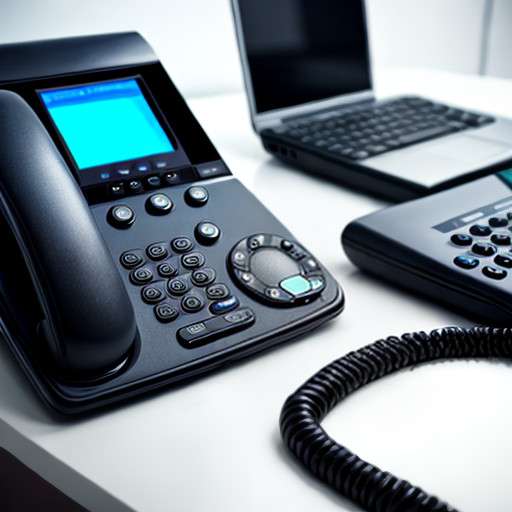Navigating the world of business phone systems can be overwhelming, especially when it comes to pricing. As a small business owner, you want to ensure that you are getting the best value for your money without sacrificing the quality of your communication infrastructure. In this comprehensive guide, we will break down the cost factors that go into business phone system pricing, helping you make an informed decision for your small business. From understanding the different types of phone systems and their associated costs, to exploring additional features and potential hidden expenses, we will demystify the pricing structures and provide you with the knowledge you need to choose the most cost-effective solution for your business. Say goodbye to confusion and hello to clarity as we decode business phone system pricing for small businesses.
1. Types of business phone systems and their costs
When it comes to choosing a business phone system for your small business, understanding the different types and their associated costs is crucial. There are several types of business phone systems available, each with its own set of features and pricing structures. 1. Traditional Landline Systems: Traditional landline systems are the older, more traditional option for business phone systems. They use physical copper wires and require the installation of a PBX (Private Branch Exchange) system. The upfront costs for traditional landline systems can be higher due to the equipment and installation fees. Additionally, there are monthly service fees and long-distance charges to consider. 2. VoIP (Voice over Internet Protocol) Systems: VoIP systems have gained popularity in recent years due to their affordability and flexibility. These systems use an internet connection to make and receive calls. The initial costs for VoIP systems are generally lower than traditional landline systems since they don’t require extensive physical equipment. Instead, you’ll need IP phones or softphones, which can be more cost-effective. VoIP systems usually charge a monthly fee per user, which includes unlimited domestic calls and various features. 3. Virtual Phone Systems: Virtual phone systems are an excellent option for small businesses that don’t require extensive hardware. With a virtual phone system, you can use your existing mobile devices or computers to make and receive calls. These systems are typically cloud-based and offer features like call forwarding, voicemail, and auto-attendants. The costs for virtual phone systems are generally subscription-based, offering different plans based on the number of users and desired features. 4. Hosted PBX Systems: Hosted PBX systems combine the benefits of traditional landlines with the flexibility and cost-effectiveness of VoIP systems. With a hosted PBX system, a third-party provider manages the PBX equipment, and your calls are routed through their servers. This eliminates the need for on-site equipment and maintenance costs. Hosted PBX systems typically have a monthly fee per user, and additional charges may apply for long-distance calls or extra features. It’s important to consider your business’s specific needs and budget when choosing a phone system. Factor in the initial installation costs, monthly fees, long-distance charges, and any additional features or equipment required. Comparing the different options and weighing their costs against the desired features will help you make an informed decision for your small business.
2. Key factors that influence pricing
When it comes to choosing a business phone system for your small business, understanding the factors that influence pricing is crucial. By decoding the pricing structure, you can ensure that you choose a system that not only meets your communication needs but also fits within your budget. Several key factors can impact the pricing of a business phone system. 1. Number of Users: The number of users or employees who will be using the phone system is a significant factor in determining the cost. The more users you have, the more lines and extensions you will need, which can increase the overall price. 2. Required Features: Different phone systems offer a range of features, from basic call handling to advanced call routing, voicemail, and conference calling. The more features you require, the higher the cost of the system. It’s important to consider the specific needs of your business and prioritize which features are essential. 3. Deployment Options: Business phone systems can be deployed either on-premises or in the cloud. On-premises systems typically require a larger upfront investment for hardware and installation, while cloud-based systems are typically priced on a subscription basis. Understanding the pros and cons of each deployment option will help you make an informed decision based on your budget and requirements. 4. Scalability: As your business grows, you may need to add more users or expand your phone system’s capabilities. Some providers offer scalable solutions that allow you to easily add or remove users without significant cost implications. Considering scalability options upfront can save you money in the long run. 5. Support and Maintenance: It’s important to account for ongoing support and maintenance costs when evaluating different phone systems. Some providers include these services in their pricing, while others may charge separately. Ensure you understand what level of support is included and if there are any additional costs involved. By considering these key factors, you can better understand the pricing structure of business phone systems and select one that aligns with your budget and requirements. Remember to compare different providers, request quotes, and ask for clarification on any hidden costs before making a final decision. With the right phone system in place, your small business can streamline communication and enhance productivity without breaking the bank.
3. Additional features and their associated costs
When considering a business phone system for your small business, it’s important to understand the additional features that may be available and the associated costs. While the basic features may be included in the base price of the phone system, there are often additional features that can enhance the functionality and efficiency of your business communications. One common additional feature is an auto-attendant, which allows callers to be directed to the appropriate department or extension through a menu of options. This can streamline the call routing process and improve the overall customer experience. However, it’s worth noting that some providers may charge an extra fee for this feature. Another useful feature is call recording, which can be valuable for training purposes, quality assurance, and compliance. This feature allows you to record and store calls for future reference. However, keep in mind that call recording may also come with an additional cost, depending on your phone system provider. Voicemail-to-email transcription is another handy feature that can save time and improve communication efficiency. With this feature, voicemail messages are transcribed into text and sent to your email, allowing you to easily read and respond to messages even if you’re not able to listen to them. While this feature can be incredibly useful, it may come with an added cost. Conference calling is an essential feature for businesses that need to collaborate with multiple team members or conduct meetings with clients and partners remotely. Depending on the phone system provider, there may be different pricing models for conference calling, such as pay-as-you-go or bundled minutes. Additionally, some providers offer integrations with popular business tools and software, such as customer relationship management (CRM) systems or helpdesk platforms. These integrations can streamline workflows and enhance productivity. However, take note that there may be additional costs associated with these integrations, either as a one-time setup fee or a recurring monthly charge. It’s crucial to carefully review the features and associated costs of a business phone system to ensure that you’re selecting the options that align with your specific needs and budget. By understanding the additional features and their respective costs, you can make an informed decision that optimizes your communication capabilities while keeping expenses in check.
4. Hidden expenses to watch out for
When it comes to choosing a business phone system for your small business, understanding pricing is crucial. Many providers advertise low monthly rates, but there can be hidden expenses that can catch you off guard. It’s important to be aware of these hidden costs to make an informed decision and avoid unexpected charges down the line. One hidden expense to watch out for is the cost of additional features. While the base price of a phone system may seem affordable, providers often charge extra for advanced features such as call forwarding, voicemail transcription, or conference calling. Make sure to carefully review the feature list and pricing details to determine whether these additional costs fit within your budget. Another potential hidden expense is the cost of hardware and equipment. Some providers may require you to purchase or lease specific devices such as desk phones, headsets, or conference room equipment. These costs can quickly add up, especially if you have multiple employees or need specialized equipment for your business operations. Be sure to inquire about any hardware costs upfront to avoid any surprises. Additionally, keep an eye out for installation and setup fees. While some providers offer free or discounted installation, others may charge a significant fee to set up your phone system. This can include configuring extensions, integrating with your existing infrastructure, or training your staff on how to use the system effectively. It’s essential to factor in these costs when comparing different providers. Finally, don’t overlook ongoing maintenance and support costs. Some providers include technical support and regular system updates as part of their package, while others charge additional fees for these services. It’s crucial to assess your business’s needs and determine whether you require ongoing support or prefer a self-service approach. By being aware of these hidden expenses, you can make a more accurate assessment of the total cost of a business phone system for your small business. Conduct thorough research, compare pricing plans, and don’t hesitate to reach out to providers for clarification on any potential hidden costs. This way, you can ensure transparency and make a financially sound decision that best suits your business’s needs and budget.









